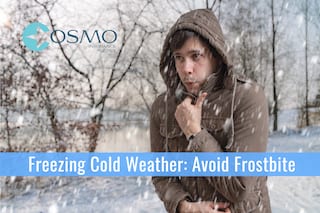A bitter cold spell is sweeping across the eastern U.S. with temperatures dropping below zero in some spots, leaving many with serious concerns for their health and safety. Frostbite, in particular, is plaguing those who have to brave the outdoors in freezing weather.
The National Weather Service (NWS) had forecast that temperatures will be “brutal” this week — with a “potentially record-breaking push” of Arctic air inundating the Northern Plains and Great Lakes by Wednesday. The cold is coming from what is known as the polar vortex, which is a “large area of low pressure and cold air surrounding both of the Earth’s poles,” according to the NWS.
Health officials are warning those who have to travel in subzero temperatures, especially for any significant period of time, to bundle up. Your fingers, toes, nose and ears are especially vulnerable to frostbite in this weather, so be sure to wear thick socks, a hat, scarf and gloves.
“Frostbite occurs when skin and underlying tissues freeze. The most common cause of frostbite is exposure to cold-weather conditions,” the Mayo Clinic explains on its website. “But it can also be caused by direct contact with ice, frozen metal or very cold liquids”
At what temperature can you get frostbite?
You can develop frostbite if the temperature falls below 32℉, according to LiveScience. But it’s wind chill that can really speed things up.
“It takes a wind chill temperature of around minus 15 degrees [F] where you start to see an increase in the incident of frostbite,” John Castellani, who works with the U.S. Army Research Institute of Environmental Medicine, previously told the site.
Frostbite can occur “in a matter of minutes” if the wind chill is dangerously low and skin is exposed.
“Frostbite happens when the body’s survival mechanisms kick in during extremely cold weather,” the National Weather Service states in a blog post. “To protect the vital inner organs, the body cuts circulation to your extremities: feet, hands, nose, etc., which eventually freeze.”
If the wind chill is -50℉ or below, officials recommend staying inside.
The risk of frostbite increases at -5℉ with low wind speeds. In a wind chill around -17℉, frostbite can occur in 30 minutes or less, according to the Mayo Clinic.
CONTACT COSMO NOW
GET A HEALTH INSURANCE QUOTE NOW
LEARN MORE ABOUT HEALTH INSURANCE
GET A DENTAL INSURANCE QUOTE
